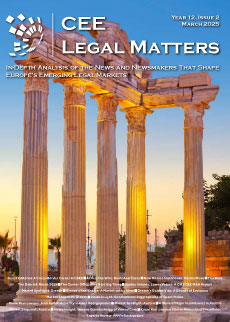The new provisions of the Code of Commercial Companies, which came into force on 15 September 2023, include a number of changes regarding cross-border and domestic mergers, divisions and conversions of commercial law companies. This is yet another major amendment to the Act, introduced less than a year after a significant amendment specifically concerning the formation and operation of capital groups, as well as changes to the rules of operation of company bodies, came into force.
These regulations will enable Polish entrepreneurs to expand their operations abroad more efficiently. For foreign entrepreneurs, in turn, the amendment means the introduction of additional options for choosing how to enter the Polish market.
While the introduction of the new solutions within cross-border reorganisations itself should be assessed positively, the new extensive procedure for obtaining opinions from the tax authorities may raise some concerns. Similar doubts relate to the imposition of an obligation on the registry courts to examine whether a given cross-border reorganisation involves abuse, infringement or circumvention of the law. These regulations may make carrying out of such a procedure lengthy endeavour and its outcome uncertain, which in turn may negatively affect interest in said procedure.
1. FLAWED PRINCIPLE OF GENERIC SUCCESSION
Thus far, Polish law limited the possibility of cross-border restructurings solely to international mergers. In addition, EU law, within the freedoms established under it, was to guarantee the possibility of transferring a company’s registered office to the territory of another Member State without the need to conduct a liquidation process.
With respect to the realities of globalisation and an intensified economic turnover within the EU, the possibility of performing merger processes on a cross-border basis alone was insufficient. Specifically, in the context of intra-group restructuring processes, very often directed at the sale of certain assets or companies within a given group, Polish law so far has not provided for the possibility of the conversion and division of companies between jurisdictions and, consequently, has not created a legal framework for the free transfer of assets using the principle of general succession. This led to the need of transferring assets on an asset-by-asset basis or through transfers of businesses or their organised parts. Such processes were therefore complex and time-consuming as their successful completion in principle required a number of consents from counterparties and, in the case of regulated activities, from the competent public authorities as well.
2. NEW PROVISIONS INCREASE THE LEVEL OF CONTROL OVER THE LEGALITY OF REORGANISATIONS
At the same time, domestic law was not properly harmonised with EU law and did not outline an unambiguous procedure allowing the transfer of a company’s registered office outside Poland without prior liquidation. In practice, entrepreneurs attempting to carry out this type of operation were confronted with resistance from the courts, which refused to delete companies from the Polish register of entrepreneurs, on the grounds that the liquidation process had not been carried out. This constituted a significant limitation both for the termination of activities within the national territory, as well as for cross-border expansion by Polish entrepreneurs. Liquidation of a company is a complex and time-consuming process, and as a rule involves the realisation of the assets of the dissolved entity and termination of its business activity (which, incidentally, contradicts the idea of transferring the company abroad).
The new regulations aim to address the above issues. They also introduce other changes, which we discuss in more detail below.
Moreover, the new provisions increase the level of control over the legality of cross-border reorganisation processes. Firstly, the amendment introduces a broader scope of the registration court’s competence with regard to legality when issuing a certificate on the compliance of the reorganisation with national law. The registration court will be able, for example, to consult administrative authorities or an auditor as part of the proceedings. Secondly, irrespective of the foregoing, the new provisions introduce the obligation to obtain a positive opinion from the tax authorities regarding the restructuring procedures carried out. This shows that the legislator’s aim is to establish a system of preventive control over the process of cross-border reorganisations. This is intended to benefit creditors who could be disadvantaged by the uncontrolled transfer of entities’ property abroad. However, the initial reactions of market participants are not surprising, as they are concerned that the new procedure may prove too burdensome and uncertain for entrepreneurs and thus unpopular.
In the previous wording of the Code of Commercial Companies, only transnational mergers were allowed to take place. Now, as in the case of domestic reorganisations, it is possible to conduct cross-border:
- mergers,
- divisions and
- conversions.
The creation of a legal framework for cross-border divisions and conversions of companies has long been propounded by practitioners. Positive experiences of entrepreneurs related to the possibility to perform cross-border mergers, which had been in place for years, made the market expect that other types of reorganisation proceedings of an international nature would also be possible. The amendment meets these expectations.
With regard to cross-border reorganisations, the new rules introduce fundamentally corresponding regulations in all three phases of the processes, i.e. in the:
- management’s phase,
- owners’ phase and
- registration phase.
Consequently, in addition to the establishment of appropriate procedures for newly introduced cross-border divisions and conversions, the existing merger procedure has also undergone significant changes.
From the perspective of Polish law, only Polish companies and limited joint-stock partnerships (but no other partnerships) may be subject to cross-border reorganisations. On the other hand, from the perspective of foreign law, only companies governed by the laws of Member States of the European Union or states which are party to the Agreement on the European Economic Area (i.e. also Norway, Iceland and Liechtenstein) may participate in such processes. Interestingly, the list of permissible legal forms of foreign companies in Annex II to Directive 2017/1132 nonetheless does not explicitly indicate such legal forms in relation to Norway, Iceland or Liechtenstein.
Companies whose purpose is the collective investment of capital raised through public issue, operating on a risk diversification basis and whose participation units are repurchased or redeemed directly or indirectly from the assets of such companies at the request of their holders, may not participate in any of the above processes.
As far as the cross-border division is concerned, it should furthermore be noted that it can only be conducted by transferring the property of the company being divided to the newly incorporated company or companies. In this respect, division by spin-off (podział przez wydzielenie) and division by separation (podział przez wyodrębnienie) are also permissible. The legislator does not therefore provide for the possibility of a cross-border division by transferring property to an existing company or companies.
As regards cross-border conversion, on the other hand, it should be assumed that not only a classic change of the legal form of a Polish company (e.g. conversion of a Polish limited liability company (spółka z ograniczoną odpowiedzialnością) into an Austrian joint-stock company Aktiengesellschaft) is permissible, but also the conversion of a Polish company into an “equivalent” form governed by the law of another country (e.g. conversion of a Polish limited liability company (spółka z ograniczoną odpowiedzialnością) into a German limited liability company – Gesellschaft mit beschränkter Haftung (GmbH)).
The regulation of cross-border conversions is supplemented by confirmation of the possibility of transferring the registered office of a limited liability company / joint-stock company abroad without the need to liquidate it. To date, the Code of Commercial Companies contained scarcely any regulations in this regard, and the transfer of the registered office of such a company was, as a rule, associated with the necessity of its dissolution and liquidation in Poland. These regulations were negatively assessed by the Court of Justice of the European Union, in particular in the widely commented case C106/16 Polbud. The amendment thus resolves the above problem of inconsistency between Polish law and the free movement of capital, which is one of the pillars of the European legal order.
3. PROCEDURE – STEP BY STEP
As mentioned, cross-border reorganisation processes, much like domestic ones, involve three main phases – management’s, owners’ and registration (judicial).
1. Management’s phase
The management’s phase consists of the preparatory activities related to the implementation of a cross-border reorganisation, the most important stage of which is the drawing up of the relevant plan by the board(s) of the participants in the cross-border process.
Cross-border process plan
The plan for each cross-border reorganisation should include basic information on the companies involved (including legal form, company name and registered office), as well as elements typically associated with the reorganisation process regardless of its international nature (e.g. proposals for appropriate ratios for the exchange of shareholder rights, information on special benefits granted to members of company bodies, etc.).
As a result of the amendment, in addition to the above information, the cross-border process plan also needs to include:
a. the proposed timetable for cross-border division/conversion. The presentation of the timetable is expected to enhance the transparency of the process, namely for the company’s stakeholders – its creditors, employees and shareholders. Interestingly, it is not necessary to propose such a timetable in the case of a cross-border merger;
b. the likely repercussions of the cross-border process on employment and the procedures by which it will be determined how employees will participate in the definition of their rights to participate in the bodies of entities operating after the cross-border process. This requirement is one way of protecting the company’s employees and also ensuring their participation in the cross-border operation;
c. security of claims proposed to creditors and the conditions for the exercise of the rights of creditors, employees and shareholders, as well as the address of the website where information on these conditions can be obtained free of charge. This requirement is also intended as one way of protecting the creditors, employees and shareholders of a company involved in a cross-border process.
Opportunity to comment on the cross-border process plan
As part of the management’s phase, the management boards of companies participating in any cross-border process are required to give separate notice to shareholders, creditors and representatives of the company’s employees (or, in the absence of said representatives, to the company’s employees) of the opportunity to comment on the plan. However, the new rules do not specify the consequences of submitting such comments on the plan for a particular process. Practice will show how this tool can be used by company stakeholders.
Management report
Within the next stage of the management’s phase, the boards of the companies involved in the cross-border process are required to draw up a report for the shareholders and employees, which lays down the legal basis and the economic aspects of the cross-border operation, including the effects of such an operation on the employees and on the future activities of the company. Alternatively, it is possible to prepare two separate reports – for the shareholders and for the employees respectively.
The preparation of a report is not required in respect of the shareholders’ portion in the case of single-member companies or where all shareholders of the company agree to waive the requirement for the report.
In the context of the employee portion , on the other hand, this requirement does not arise if the company undergoing reorganisation and its subsidiaries do not employ any staff other than those who are part of the company’s management. This means that where such a company (and its subsidiaries) employs staff, it will always be necessary for the management board to prepare a report in the employee portion and the shareholder will not be able to exempt the body from preparing such a document.
Examination of the cross-border process plan by an expert and issuance of the opinion
As a general rule, the plan of cross-border operations is subject to examination by an expert. However, this obligation is excluded if all shareholders of the company agree to waive this requirement. In the case of single-member companies, it is not necessary to examine the plan and issue the opinion.
Submission of documents/information on cross-border reorganisation to the registry court
Another common feature of cross-border processes is the requirement to actively inform the registration court of the planned process. It is incumbent on companies participating in a cross-border operation to file documents/information regarding the process with the registry court. Two ways of making such a filing have been introduced.
The first includes the obligation to provide the court with the relevant documents, i.e. the plan for the cross-border reorganisation process, and notification of shareholders, creditors and representatives of the company’s employees (or, in the absence of said representatives, the employees) of the opportunity to submit comments to the company regarding the cross-border reorganisation plan.
The second involves submitting a range of information without the need to produce the above documents. Such information involves the data of the participants in the cross-border process, the indication of the relevant registers, the conditions for the exercise of the rights of creditors, employees and shareholders and the address of the website where the above-mentioned documents and the expert’s opinion (if any) are made available free of charge.
Notification to shareholders
In all cross-border operations, the management boards of the companies involved in the process are also required to traditionally notify the shareholders twice of their intention to carry out such a process, in the manner provided for convening shareholders’ meetings and within the relevant regulatory deadlines.
2. Owners’ phase
Adoption of a resolution on cross-border reorganisation
The owners’ phase of a cross-border reorganisation process boils down to the adoption of the relevant resolution of the shareholders’ meeting.
Resolutions to this effect require a majority of three-quarters of the votes representing at least half of the share capital, unless the articles of association prescribe stricter conditions for the required majority. In the case of a cross-border division and conversion, however, the majority may not exceed 90% of the votes. In terms of the resolution on a cross-border reorganisation, the effectiveness of such a reorganisation may be conditional on the approval by the shareholders’ meeting of the terms of participation of the employees’ representatives.
At this point, it is worth noting that the legislator has introduced an upper limit to which the articles of association may more strictly enforce the requirement to obtain a majority of the shareholders’ consent to conduct a cross-border division and conversion.
On the one hand, it was set at a fairly high level of 90% of votes. On the other hand, market practice shows that, in view of the importance of a company’s reorganisation (particularly cross-border) and the potential impact on its shareholders, very often the implementation of such a process required unanimity of shareholders. This was also the case for joint venture projects, where the minority shareholder was guaranteed the right to oppose the implementation of such a significant action without its consent.
Share repurchase
The relocation of activities outside Poland, which is connected with a cross-border reorganisation process, may constitute a significant impediment for shareholders in exercising their rights from the shares they hold. This is particularly the case for non-professional natural persons holding small blocks of shares in a given company. In view of the above, the legislator provides for a procedure to enable the shareholders who are against the cross-border reorganisation to exit the company.
The new regulation stipulates that the right to request the repurchase of shares for a price corresponding to the fair value is vested in a shareholder who voted against the resolution on the cross-border reorganisation and who requested that his or her objection be recorded no later than at the shareholders’ meeting at which the resolution was adopted or who was unjustifiably prevented from participating in the shareholders’ meeting at which the resolution on the cross-border operation was adopted. As with squeeze-out procedures, the effectiveness of the repurchase depends on the payment of the repurchase price or the deposit of an amount equal to that price with a court.
3. Registration phase
Securing creditors’ claims
Trading practice indicates that the transfer of part of a company’s assets outside Poland, resulting from a cross-border reorganisation process, may be a tempting opportunity for entities wishing to prevent or significantly hinder the enforcement of claims against them.
In order to prevent the above practices, the creditors of a company participating in a cross-border reorganisation are entitled to demand security for their claims not due at the time the plan for the cross-border reorganisation process is disclosed, or made available if they substantiate that their satisfaction is jeopardised by such a process. The demand must be made within the time limit provided by the legislation. At the same time, the mere filing of an application by a creditor does not suspend the process of issuing a certificate by the registry court on the compliance of the cross-border reorganisation with Polish law, as regards the procedure subject to that law.
Application for a compliance certificate of a cross-border process with Polish law
Due to the fact that cross-border reorganisation procedures, in essence, require the application of laws applicable in different jurisdictions, it is necessary to have in place appropriate legal mechanisms to confirm that, as far as Polish law is concerned, a given procedure has been conducted in a compliant manner. One such instrument is the certificate of compliance of the cross-border process with Polish law, issued by the competent registration court.
It is incumbent upon the management board of a Polish company participating in a cross-border reorganisation to submit an application for such a certificate to the registration court, together with an application to the competent tax authority for an opinion and the relevant attachments (inter alia, the plan of the cross-border reorganisation, a copy of the resolution on such a process, a statement of the management board concerning the place of effective management or business activity of the company after the reorganisation, or a certificate of the Social Insurance Institution (ZUS) concerning the number of insured persons and not being in arrears in the payment of contributions).
The registration court is obligated to immediately send the application to the Head of the National Fiscal Administration (KAS) for an opinion. The subject of the opinion in each case is:
a. to assess whether there is a reasonable prospect that the cross-border reorganisation may (i) constitute a tax avoidance activity or an element of a tax avoidance activity or (ii) be the subject of a decision issued by means of measures restricting contractual benefits or (iii) constitute an abuse of rights within the meaning of the Act on Goods and Services; and
b. to confirm that the company’s monetary liabilities to tax authorities or non-tax budget receivables of a public law nature, for the assessment or collection of which the National Fiscal Administration authorities are competent, are satisfied or secured.
The opinion should be issued within a maximum of three months (in justified cases, this deadline may be extended by another three months), and in the course of issuing it, the Head of the National Fiscal Administration may also turn to other authorities (e.g. the minister competent for public finance or the General Inspector of Financial Information).
The registration court should issue the certificate to the company within three months from the date of the filing the application. In some cases, this deadline may be extended by three months.
The court then enters a reference to the cross-border reorganisation in question in the register, unless it finds that it serves to abuse, infringe or circumvent the law. In such a case, the registry court may request an opinion from the competent authorities in order to examine the indicated scope of the company’s activities or consult an expert. However, a presumption has been introduced that it will not be an abuse, infringement or circumvention of the law to transfer, in a cross-border reorganisation, the effective management or business activity to another Member State or a state that is party to the EEA.
The previous legislation did not explicitly impose on the registration courts the duty to control reorganisation processes in terms of illegality. On the one hand, the processes in question may be used for purposes contrary to the law or aimed at circumventing it, and therefore, explicitly granting the courts the right to exercise control in this respect appears to be a positive development. On the other hand, it raises the concern that such a review will impede the smooth conduct of the trial and significantly prolong it. Only the practical application of the new provisions will determine to what extent the courts will interfere in reorganisation processes in order to confirm their legality.
The importance of the certificate on the lawfulness of a cross-border reorganisation is manifested by the fact that such a certificate should be regarded as conclusive proof of the due completion of the procedures and formalities as regards the procedure governed by the law applicable to the company involved in the cross-border reorganisation.
In view of the international nature of the reorganisations in question, the legislator has determined that until the date of receipt of the compliance certificate of the cross-border process with national law, the cross-border reorganisation will be governed by the law of the state of the registered office of the reorganised entity. Subsequent to that date, the jurisdiction of the applicable foreign law will already be competent.
4 SOURCE OF THE AMENDMENT
The amendment implements the so-called EU company law package comprising a number of directives of the European Parliament and of the Council (EU), i.e. Directive (EU) 2019/2121 of the European Parliament and of the Council of 27 November 2019 amending Directive (EU) 2017/1132 as regards cross-border conversions, mergers and divisions of companies and Directive (EU) 2019/1151 of the European Parliament and of the Council of 20 June 2019 amending Directive (EU) 2017/1132 as regards the use of digital tools and processes in company law.
5 OPINION ON THE AMENDMENT
The introduced possibility of cross-border divisions and conversions as part of a reorganisation meets the expectations of both practitioners and entrepreneurs and as such, it should be viewed positively.
The regulations on cross-border conversions provide a legal framework for conducting the long-awaited smooth and formally regulated transfer of activities across borders, without the need for an arduous liquidation procedure.
Cross-border divisions, namely division by spin-off and separation preceding the sale of shares in the resulting new companies, will provide an interesting alternative to cross-border asset deals involving the disposal of a company’s business or its organised part. It also appears that both cross-border divisions and conversions may be of interest to companies planning to exit Poland without going through the liquidation process.
By Maciej A. Szewczyk, Partner, Pawel Szumowski, Senior Associate, and Marika Grzybowska, Associate, Wolf Theiss

















